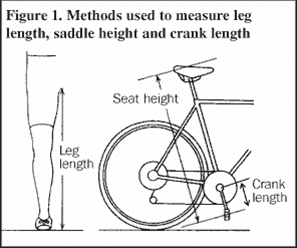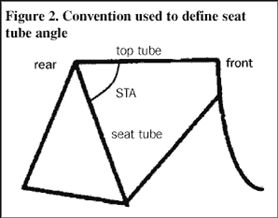Biomechanics of cycling - Improving performance and reducing injury through biomechanics
Biomechanics is the science concened with the forces that act on the human body and the effects these forces produce. These forces determine how parts of the human body move during the performance of a skill and in short determine technique. Therefore knowledge of biomechanics can help improve cycling technique to improve performance and reduce injury in cyclists of all ability levels.
Mechanisms of cycling biomechanics
Understanding mechanisms of cycling biomechanics allows recreational cyclists to position themselves for optimal comfort and efficiency and competitive cyclists to improve their performance in competition. It also helps people undergoing physical therapy to attain maximum benefits from the use of stationary bicycles, and reassures therapists that the demands placed on their patients will improve their condition rather than hinder it.
An important force in cycling is power output with every cyclist (recreational or competitive) having to overcome this in order to move the bicycle in different conditions. Being able to apply pedalling forces effectively is extremely important, while correct body positioning is crucial for successful performance and injury prevention. This article considers some variables of rider positioning and equipment set up that are important to all cyclists.
Saddle height in cycling
Changing the saddle height alters a number of variables in cycling including joint angles, muscle lengths and the force output muscles can produce. Research has reported the optimal seat height (seated in an upright position) to produce the most power output is 109% of leg length (figure 1). This height is considered most efficient for track sprint cyclists who have to produce extremely high power outputs for very short periods. A 1% difference in saddle height in either direction - from 109% of leg length - would produce approximately 1% less power.
Moderate intensity cycling / steady state conditions
In moderate intensity cycling, which is performed under steady state conditions, a saddle height between 105% and 107% of leg length requires the lowest oxygen consumption. By using a lower oxygen consumption for the same power output means an increased efficiency, which is important for touring and endurance cyclists who have to ride for long periods.

From The Physiology and Biomechanics of Cycling
In terms of performance, a saddle height of 109% of leg length is often referred to as the 'maximum saddle height' and is recommended for short-term power output, whereas a saddle height of 105-107% is known as the 'optimum saddle height', regarded as most efficient for events of lower intensity and longer duration.
The saddle height also affects the activity of the muscles in the leg. As saddle height decreases the amount of muscle activity in the quadriceps and hamstring muscle groups increases. A greater saddle height allows cyclists to pedal with greater ease especially at high workloads.
Crank length in cycling
Crank length is another variable that contributes to force production. A change in crank length can alter the distance between the saddle and the pedal but with different consequences. Increasing the length of the crank allows for greater torque production (force of the pedal rotating) and decreasing the length of the crank would increase the amount of muscular tension involved in force production, which could lead to earlier fatigue. Neither of these occur if you just raise or lower the saddle height.
There are limitations on the length of the crank with longer cranks assisting in hill climbing while shorter ones are best suited to track events. The crank length must however allow the pedal to clear the ground when cornering and must not interfere with steering of the front wheel and must therefore be short enough for these circumstances.
Crank lengths can also affect the comfort of the cyclist. If cranks are too long the hips and knees may have to flex (bend) too much at top dead centre (TDC) position (highest point of the pedal) and can cause great discomfort.
When changing crank length, the saddle-to-pedal distance must be altered correspondingly to maintain the same effective saddle height. Since joint and connective tissue injuries have been associated with over-long cranks it is recommended caution is needed when experimenting with crank lengths.
Seat tube angle in cycling
The positive interaction between the cyclist and bicycle required to maximise cycling performance is dependent on the design of the bicycle. The seat tube angle (STA) between the top tube and the seat tube (see figure 2) is important since it determines the rider's comfort level.

The STAs cyclists use changes depending on the competition. Competitive road cyclists claim that STAs between 72° and 76° are most effective for optimal performance, while competitive triathletes often ride with steeper STAs of 76-78°. A steeper STA allows a rider's body weight to be positioned further forward over the crank with triathletes believing this allows for greater comfort, efficiency and power production when using aerodynamic handlebars. There however may be advantages gained from selecting a bicycle with an STA best suited to the chosen terrain.
Researchers examining the effects of STA during moderate intensity cycling have reported more oxygen is used at shallower STAs (<76°), compared to steeper STAs (>76°) making performance easier when using a steeper STA (>76°).
Standard recommendation for cyclists
The standard recommendation for cyclists on STA has been to select an angle that will result in the kneecap of the forward leg being directly over the pedal axle when the cranks are horizontal. Although not in the scientific research, it is believed that this position provides for even weight distribution.
Saddle fore-aft position
The fore-aft position refers to the location of the rear of the saddle behind a vertical line drawn to the centre of the crank axle (point of crank attachment). The saddle is positioned to allow a plumb-line dropped from the patella to bisect the pedal axle when the crank is in the horizontal forward position. This enables the hip and knee extensor and flexor muscles to be fully utilised, which minimises strain on the knee joint; any change in the fore-aft position of the saddle will change the joint angles.
The position of the knee over the pedal axle should be regarded as the starting point from which minor adjustments can be made. A saddle positioned too far forward will decrease the knee angle at TDC and threfore increase the activity of the quadriceps to extend the knee, raising the risk of injuries. Conversely, a saddle positioned too far backward reduces the effective working of the hamstrings, gluteus maximus and gastrocnemius muscles.
Triathletes and time trialists
Triathletes and time trialists have experimented with the position of the saddle, with many adopting an extreme forward posture combined with 'maximum saddle height' with the aim to reduce air resistance while maximising power output. For safety reasons, such extreme positions are confined to time trial and track events only.
Shoe-pedal interface
One of the main reasons why cyclists obtain knee injuries is due to the connection of the foot with the pedal. It is accepted that the use of cleated (wedged) cycling shoes on pedals with toe clips or the more recent clipless pedal system allows a better knee alignment and greater power to be produced compared against regular sport shoes.
Toe clips are also used to enhance performance by enhancing efficiency early in the pedalling cycle. However the introduction of clipless pedals has made injuries associated with incorrect positioning and alignment of the foot more evident as fixing the cyclists foot to a pedal during cycling places stress on the knee during pedalling. As a result, a pedal system was designed to provide 'float' - a rotational allowance of the shoe in relation to the pedal.
Placing the ball of the foot directly over the pedal helps to decrease stresses across the knee ligaments and is the most efficient cycling position. A more forward foot position, with the pedal either in the arch of the foot or under the heel, increases hip extensor and flexor activity but does not allow the full range of ankle motion needed for effective force production.
Some cyclists prefer to mount the cleats on their cycling shoes in such a way that the ball of the foot is slightly in front of or behind the pedal axle. When the ball of the foot is ahead of the axle, the effective lever arm from the ankle to the pedal axle is shortened, requiring less force to stabilise the foot on the pedal and putting less strain on the Achilles tendon and gastrocnemius. Triathletes and time trial specialists favour this position as it allows them to produce more force when using large gears, even though it limits their ability to pedal at high cadences.
Positioning the ball of the foot behind the pedal axle effectively lengthens the lever arm from the ankle to the pedal axle, making it more difficult for the foot to act as a rigid lever, and the Achilles tendon and gastrocnemius have to work harder to stabilise the foot on the pedal. Track cyclists favour this position since it allows them to pedal at higher cadences during fixed gear events.
Upper body position in cycling
The handlebar design popular in triathlons and time trials was developed to improve the aerodynamics of cyclists by allowing them to adopt a 'tuck' position similar to that used in downhill skiing. An aero handlebar with elbow rests allows the rider to adopt a position with a flatter back and reduced frontal area. Ultimately, the flexibility of the cyclist may determine the most comfortable position on the bicycle
Optimum power output in cycling
To achieve optimum power output and avoid injury it is important that cyclists are positioned correctly and the bicycle is set up properly. Saddle height, crank length, seat tube angle, saddle fore-aft position, shoe-pedal interface and upper body position are all factors to be considered to improve cycling performance and reduce injury.
Courtesy of PPonline.co.uk
References
1. The Physiology and Biomechanics of Cycling. New York: John Wiley and Sons, 1978
2. Exercise and Sport Sciences Reviews, vol 19, pp 127-169, 1991
3. Medicine and Science in Sports and Exercise, vol 9, pp 113-117, 1977
4. Medicine and Science in Sports and Exercise, vol 8, pp 119-126, 1976
5. Medicine and Science in Sports and Exercise, vol 27, pp 730-735, 1995
6. Journal of Sports Sciences, vol 15, pp 395-402, 1997

Latest health and fitness news
 All news stories
All news stories
Latest quizzes and tests
 All quizzes &
tests
All quizzes &
tests
|


